Principles of Budo: Ono-ha Ittō-ryū
Author: Hiden Staff Translator: Mark Hague
※0270.jpg)
Go Straight in to Go Straight in
The photo on the left shows the first technique of Ono-ha Ittō-ryū – the most secret Kiriotoshi (kata name: Hitotsugachi). I believe many people are familiar with this technique, which is the symbol of Ono-ha Ittō-ryū, but among even those who think they can do it, how many can say that they could do this technique in an actual situation on a real battlefield?
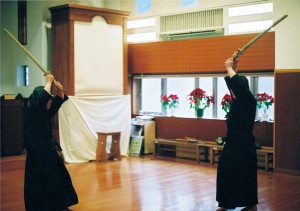

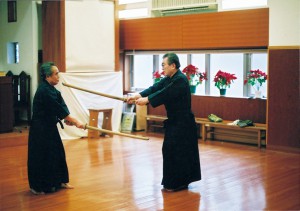
There are probably a lot of youngsters who copy what they see in chanbarra movies and try to stop a cut coming toward them by turning their swords sideways, or jump back or to the side to get out of the way. These techniques are fine when play-fighting, but when facing an opponent with a real sword, losing is not an option. When you face an opponent who is cutting toward you, standing steady in the face of this attack while doing the same movement against him requires a staggering amount of courage. At this point, it could be called a miracle technique. Moreover, it appears that you are cutting after, or later than, your opponent but still win in the end. For these very reasons it is considered a secret, but how do you actually do it? I was fortunate enough to have the 17th Soke of Ono-ha Ittō-ryū, Sasamori Takemi, provide a thorough explanation.
Sasamori Soke: “The kumitachi has fifty techniques, and when you learn them all completely you ultimately return the very first technique. The other forty-nine techniques are there to help you master the very first one.”
 Ono-ha Ittō-ryū contains the phrases: Itto sunawachi Banto (一刀即万刀) and Banto sunawachi Itto (万刀即一刀). The essential meaning of these sayings seems to describe this training structure. This brings to mind the saying in boxing: “He who masters the left jab masters the world,” and the idea behind Kiriotoshi is not far from this.
Ono-ha Ittō-ryū contains the phrases: Itto sunawachi Banto (一刀即万刀) and Banto sunawachi Itto (万刀即一刀). The essential meaning of these sayings seems to describe this training structure. This brings to mind the saying in boxing: “He who masters the left jab masters the world,” and the idea behind Kiriotoshi is not far from this.
The first five of the fifty techniques of the kumitachi are considered the foundation of all the
rest. These are:
1. Ipponme – Hitotsugachi
2. Nihhonme – Mukaitsuki
3. Sanbonme – Tsubawari
4. Yonhonme – Gedan kasumi
5. Gohonme – Wakigamae no tsuke
Sasamori Soke said, in a rather off-handed way: “Actually, doing all five of these is really doing Kiriotoshi.” I had seen these techniques numerous times before, however, and they all looked different to me. They did not strike me as all being Kiriotoshi.
When I was not entirely convinced by his comment, Soke said: “You probably think that Kiriotoshi is just going straight forward and cutting down. That is not the case. It can be done on an angle, across the horizontal plane, and can be in a stab as well. They are all Kiriotoshi.”
At this point, a small light bulb went on in my head. It was only natural that there would be many types of patterns, such as a Kiriotoshi that cuts straight down, one that comes at an angle, one that comes from the vertical, and one that comes from a downward angle, and that these would be arranged in a kata that contained cuts that came from various directions. But I wondered if only five would be enough in a training structure that contained fifty techniques?
What are important are the principles. Even though what you see all appear to be different, they are all Kiriotoshi because they are all founded on the same principles. Said another way, it is because you follow the principles that underpin it that Kiriotoshi will still work in an actual combat situation, even though you may not know from what angle your opponent will cut.
But, I am getting ahead of myself. These five techniques were all developed based on the same underlying foundational principle. However, there is more than just one principle in these techniques. There are several that all techniques have in common, and I would like to consider each one in order. If you read until the end of this article, I am sure you will agree that Kiriotoshi contains them all.
The Principle of Sharin Zenten
Sasamori Soke: “The most important principle is something we call sharin zenten (車輪前転 ). This refers to a wheel rolling forward. But, if you stop moving forward after you raise your sword up, it is useless. You beat your opponent by riding over his sword, which leads to uwadachi (上太刀), and this is done based on how a wheel rotates as it moves forward.”
This is not a technique where you defend yourself by bouncing your opponent’s sword off of yours after you hit it but a technique where you enter into your opponent and ride over his sword or “swallow” it.
Sasamori Soke: “We call the relationship between the two swords, ‘crossing over to’ (watari komi 渡り込み). Don’t try to move your opponent’s sword out of the way when the two swords meet, but just slide into him with your entire body and your sword tip will naturally cross over to him.”
One point of Kiriotoshi that Soke said was difficult for beginners to grasp is that they try to hit their opponent’s sword. Soke noted that they often find this a barrier to progress when they first start to train. When they try to hit their opponent’s sword, they bring their swords down at an angle. When Kiriotoshi is done this way, it takes close to a miracle to pull it off properly.
According to Sasamori Soke, there is a technique called Kiriotoshi even in modern kendo. However, rushing forward to try to hit the opponent is no good.
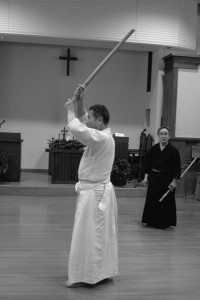 Here I would like to address an important concern, which is: my opponent started to move first, so will I have enough time to react? In fact, when you raise the sword overhead to jōdan to do Kiriotoshi, you only hold it at a shallow forty-five degree angle. If you don’t actually do this, you will not be able to really understand, so I would encourage you to try it. If you cut down from a position of forty-five degrees after thinking let’s cut! you will be able to cut down in time. In other words, even if you move after your opponent, you still have sufficient time to react to his sword that has already started moving.
Here I would like to address an important concern, which is: my opponent started to move first, so will I have enough time to react? In fact, when you raise the sword overhead to jōdan to do Kiriotoshi, you only hold it at a shallow forty-five degree angle. If you don’t actually do this, you will not be able to really understand, so I would encourage you to try it. If you cut down from a position of forty-five degrees after thinking let’s cut! you will be able to cut down in time. In other words, even if you move after your opponent, you still have sufficient time to react to his sword that has already started moving.
Of course, it goes without saying that I am not suggesting that this shallow swing lets you win
based on speed. This is not a matter of winning through speed; the secret to beating your opponent is to move after he does by using sharin zenten.
If the opponent were to stop moving this would be irrelevant, but it is only natural that your
opponent will be facing you. The wheels rotate toward each other from opposite directions, and when they collide, the wheel that rotates later will swallow up the wheel that rotates earlier. What this means that a necessary precondition of doing Kiriotoshi is starting your cut after your opponent’s.
 The Principle of Sharin Zenten
The Principle of Sharin Zenten
If you were to describe in words what happens when you do Kiriotoshi, it probably goes something like: “When the opponent cuts down, deflect his blade away with the side of yours and cut into him.” Because the direction your sword cuts is the same as your opponent’s, you would think this could not possibly happen in an actual situation, except by accident. This is because you think of the cut as a line or a point, or consider the probability of this happening. But the true nature of this phenomena of Kiriotoshi is found in the forward rotation of a wheel. You will be able to do uwadachi instantly by rotating everything forward like it was a tire moving forward around its axle and meeting your opponent’s sword as if you were enveloping his downward cut. This is not a mere contest of speed, nor an issue of the trajectory of his sword, nor is it a form of counterattack. This rotation is a principle related to all of the other techniques. For example, techniques one through five look completely different, but they are all Kiriotoshi because they put into practice the principle of sharin zenten that is common to all.
Within Defense is an Attack: the Principles of Kenchūtai and Taichūken
So let’s take a look at the second technique of Mukaitsuki. The essential core of this technique is presented in the photos in the upper left. When the swords are touching, you copy the motion of your opponent when she starts to stab and, while controlling her stab, ride over her sword and stab into her [this is called noritsuki in Japanese, trans.].
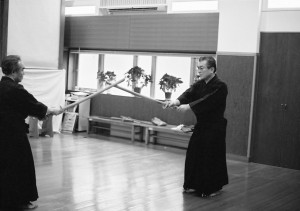
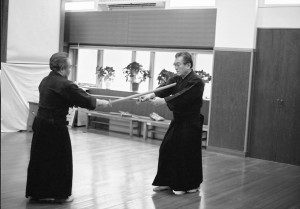
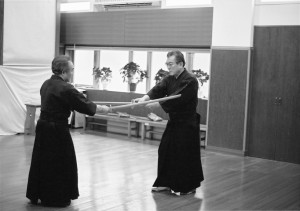
The physical relationship of where both swords touch and the angle at which they intersect, in and of itself, of does not change. When Shikata does this technique, he does noritsuki in a single, swift motion. Like the first technique of Ipponme, the opponent is the one who moves first. Noritsuki turns into an attack at the same time it is being used to defend against the opponent’s stab.
Sasamori Soke: “We call a situation where attack and defense become one, kenchūtai (懸中待) and taichūken (待中懸). This is also an important saying that expresses a principle of this school.”
This saying means that while launching a strike there is waiting, and within waiting there is launching a strike. It is also said that a defense resides in an attack, or that you attack and defend at the same time. Sharin zenten is indispensable when putting this attack-and-defense-are-one concept into practice.
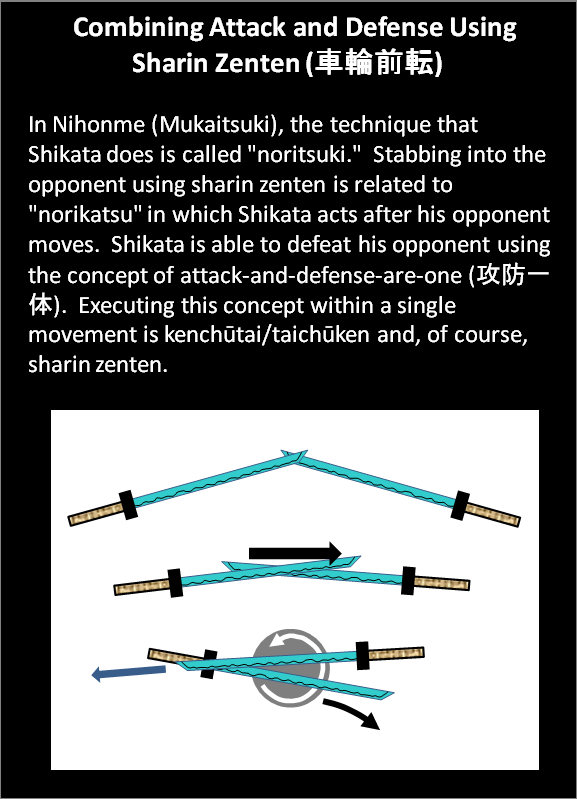 Of course, putting this concept into practice within a single movement is easier said than done. Whatever you do, if you block your opponent’s attack and then counterattack, it is a rhythm of two beats. It is inevitable that a person would normally consider attack and defense to be two separate actions that require two beats, but the key to being able to do this in one beat is clearly illustrated through the technique of Sanbonme.
Of course, putting this concept into practice within a single movement is easier said than done. Whatever you do, if you block your opponent’s attack and then counterattack, it is a rhythm of two beats. It is inevitable that a person would normally consider attack and defense to be two separate actions that require two beats, but the key to being able to do this in one beat is clearly illustrated through the technique of Sanbonme.
The Principle of Kenchūtai and Taichūken
The principle of “Within an attack there is waiting (kenchūtai) and “within waiting there is an attack(taichūken), implies that attacking and defending are unified into the same motion (kōbō ittai 攻防一体). In samurai dramas in movies and television, a fighter blocks a cut then counterattacks with two separate movements; however, in real combat this timing is too slow. The point of Kiriotoshi is to be able to defeat your opponent in a single beat. If you think of attack and defense as only two discrete actions, a fight will merely devolve into a contest of speed and strength.
Don’t Stop! – Do it Within One Beat: the Principle of Ichiyō Raifuku
Sanbonme (Tsubawari) is a technique where you just barely back out of range of your opponent’s cut, let him strike your tsuba, as the name implies, and then counterattack. In the photos it may look like you step back, deflect his sword, then step forward and counterattack, but the actual movement where you step back and then step forward is done instantaneously, in one beat.
Sasamori Soke: “This motion is not pulling back, but hauling (taguru 手繰る )”.



……What? I had thought these two words had meant the same thing. What’s the difference?
Sasamori Soke: “Taguru refers to when something spins out thread, like a silkworm. This is the motion of spinning thread onto a wheel and paying it out. You don’t just pull a string; you pay it out while pulling it in. In Sanbonme, you just don’t pull back; it is important to go forward using the hauling force.”
Ultimately, in modern terms, they teach to: “Quickly back up and then quickly go forward. Go as fast as possible!” You start out slow as a beginner and gradually learn to do it faster. However, there is a fundamental difference in the nature of the movement. This difference is, of course, in the rotation.
Furthermore, they say that the feeling of taguru is not just in Sanbonme but is a fundamental principle found in all of the techniques, to include Ipponme. When doing sharin zenten, they don’t teach to just “go forward!” An essential point is to get the opponent to come to you.
The Principle of Ichiyō Raifuku
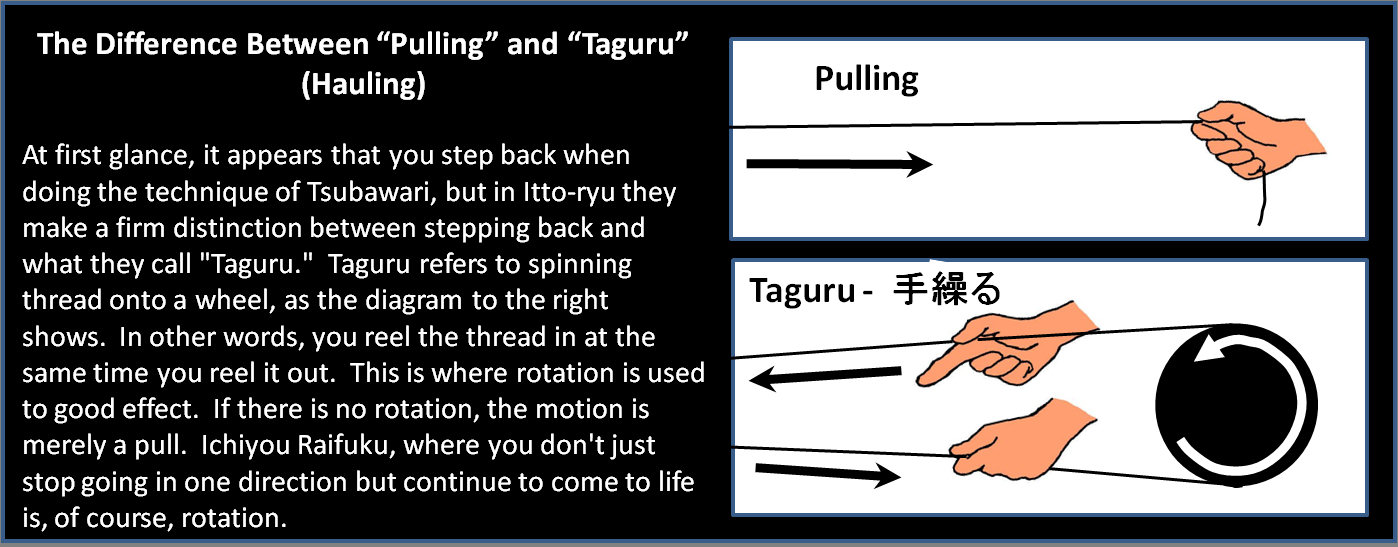
“Ichiyō Raifuku” (一葉来復) refers to when a leaf drops to the ground and then comes back to life. Also spelled 一陽来復, it is a word that means to transition from winter to spring, and also winter solstice.
However, though it certainly is like the transition of the seasons, it is a condition where you immediately reverse direction without pausing and, of course, is executed by using sharin zenten. You don’t use a rhythm of two beats, where you step back then go forward, but pull back and go forward a single beat.
Meet Your Opponent’s Attack after Getting Her to Strike: the Principle of Sen Sen no Sen
No matter which kata I observed, the pattern was that Uchikata moved to attack first, and then Shikata went forward to meet it. Hence, they all seemed like techniques that use go no sen (後の先) timing. In fact, there is quite a lot of written material that presumes that Kiriotoshi is a technique that uses this type of timing.
Sasamori Soke: “The reality is that Kiriotoshi entails getting the opponent to strike. If you don’t do this, you will not be able to do Kiriotoshi effectively. Therefore, it is not a technique done with go no sen timing, but one done with sen sen no sen (先先の先) timing.”
Sen sen no sen timing is a situation where one reads what the opponent is going to do before she does it. In many situations, it means psychological warfare, but it can be easily understood in the physical realm through doing Yonhonme (Gedan kasumi).
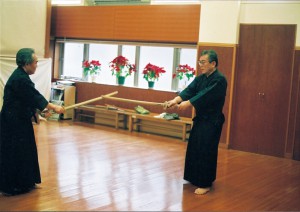


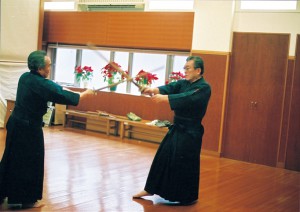

This technique starts out with the sword tips overlapping. From there, make a subtle movement to see what your opponent will do by pushing her sword tip away. When you do this, your opponent will not like holding up your sword as it pushes down. She will have no choice but to pull her sword away and cut toward you. Just when she cannot take it anymore and cuts, do Kiriotoshi. Get her to strike and then go forward to meet it. The kata is a schema where you get your opponent to cut, and then intercept her attack as she is cutting. This is certainly the structure of sen sen no sen timing. Deftly checking the movement of your opponent’s sword while she is in the gedan kasumi kamae, a stance from which it is difficult to know what she is going to do, is the strategy of Yonhonme.
The Kiriotoshi that you can see at the end of this technique is the same Kiriotoshi you can see in Ipponme (Hitotsugachi). Is this called a Kiriotoshi like the first?
Sasamori Soke: “That is correct. Ipponme, as well, is a technique where you get your opponent to strike. When you face your opponent, if you start to think things like, I should try to figure out how she will attack, or, I have to cut into her first, or even, I will do Kiriotoshi! you have already lost. Don’t engage in that type of thinking or a situation will pop up when what your opponent does will be different than what you had expected. You need to be able to grasp this point to do Kiriotoshi. Don’t entertain unnecessary thoughts, don’t let yourself become distracted by anything, and in that state of mind, move forward to meet your opponent’s attack. This is how you effectively apply the Kiriotoshi that I explained earlier. We call this type of timing Taisen (大先).”
The meaning of this may be the most difficult to understand. It is the mental state of having a mind as clear as a mirror and as calm as still water (meikyo shisui 明鏡止水). Don’t try to predict what your opponent will do, don’t go forward to attack her, and don’t allow yourself to become distracted, but merely concentrate on what is coming toward you. After you start to do this, you will really learn what it means to go forward and meet your opponent’s attack. Once you reach the point where you start to do this, your Kiriotoshi will become a technique that would pass muster in actual combat.
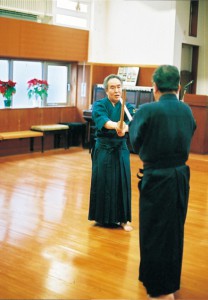
 The Principle of Sen Sen no Sen Timing
The Principle of Sen Sen no Sen Timing
Because Shikata moves after Uchikata, there is a tendency to interpret this as go no sen (後の先) timing, but, in fact, all of the techniques in Ono-ha Ittō-ryū use sen sen no sen (先先の先) timing. In other words, Shikata does not merely let Uchikata do whatever she wants but makes her think sne has no other choice but to move. If Shikata were to merely try to respond to Uchikata’s attack, the outcome of the contest would be determined by who was quicker, but it is much better to move toward your opponent after knowing how she will attack. The principle of taking advantage of the counterattack is also sought after in the sports world, and in kenjutsu, you are sure to win if you can achieve this skill. Of course, this provides a glimpse into the depths of the traditional martial arts upon which our ancestors staked their lives.
Go Straight Into Your Opponent’s Core: The Principle of Going Straight Into the Center
This brings us to the last of the techniques, Gohonme (Wakigamae no tsuke), which contains no movements at all that look like Kiriotoshi. Sasamori Soke insisted, however, that it was, in fact, Kiriotoshi.
The essential part of Gohonme is in the following photographs. You meet your opponent face to face, with the swords crossed, balancing each other out. In that situation, you start to walk forward. Even though you walk forward, don’t allow the swords to separate. This is called sokui tsuke. This is just like having both swords stuck together and is also called shikko no tsuke [shi (漆 ) means laquer and ko(膠)means glue, trans.]. When looked at from the side, it appears that both sides are pushing against each other’s swords, but that’s not the case.


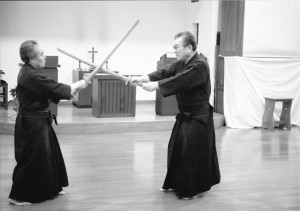
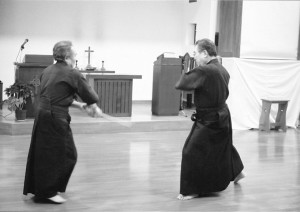
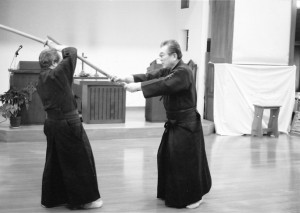
Sasamori Soke: “If you were to push against your opponent’s sword, you would be beaten by someone who is stronger than you. You should avoid doing that and just face your opponent directly and go straight toward him. This creates a balance of forces. As you might expect, this also is an example of sharin zenten.”
When a two wheeled vehicle, like a bike or motorcycle, moves forward, it maintains equilibrium so it doesn’t fall over to the side, and this seems to be the common theme here.
Uchikata, who pushes back against Shikata as he rolls forward, steps back while maintaining the proper distance, tries to keep his sword in a balanced state against Shikata, but is gradually backed into a corner. As he is forced back with more and more pressure from Shikata, Uchikata looks for a way out of his predicament and tries to wrench Shikata’s sword down and away. The instant he does this, Shikata rips his sword out from under it, and then strikes Uchikata.
Sasamori Soke: “It is one of the secrets (gokui 極意) of Ittō-ryū to ‘Go straight into the center of the opponent.’ The center looks strong, but is weak. Even in such sports as tennis and table tennis, it looks useless to go straight in, but even in the center there are weak points that are easy to penetrate. This is the reason you should go straight in. Going straight in is the most effective
approach. If something comes straight toward you, you have no choice but to go straight toward it. It is no good to try to avoid it. If a cut comes toward your forehead, you should go straight toward your opponent’s forehead. Even when an arrow is fired toward you, do not try to evade it but go straight toward it. This is a secret.”
Now I get it. This is the explanation of Kiriotoshi.
The Principle of Entering Straight into the Center: Chūshin Chokunyū
“Go straight forward, directly into your opponent” (中心直入) is an extremely simple, yet vitally
important principle. When the opponent comes straight toward you, the way to stay alive is not to avoid the attack but to go straight forward into it. The very center appears to be strong, but it is actually a weak vulnerability. You can attack this vulnerability by attacking straight to the front. “Won’t I lose?” is a possible concern. Ignoring this self-doubt and going straight forward is the strongest approach. In Ittō-ryū, there is a lesson that says “to cut down everything that is right in front of you.” It may appear to be extreme but is indisputably a secret.
Strike!
After seeing the kata of Gohonme and the various principles that go with it, I was getting a practical understanding of quite a bit of what underlies Kiriotoshi. But, in the end, I wanted to clear up a concern I had that others also likely harbor, which is: what happens if your opponent slightly changes the angle of attack of his blade? Won’t this be enough to keep you from doing Kiriotoshi effectively?
“As I mentioned before, Kiriotoshi is not just done against an opponent who cuts straight down, it can also be used against a diagonal strike or a horizontal cut. For example…..” Sasamori Soke said as he demonstrated this himself. “In the case of an opponent who cuts with a slight kesagiri, you still do Kiriotoshi.”

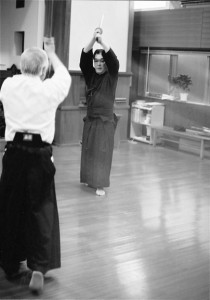
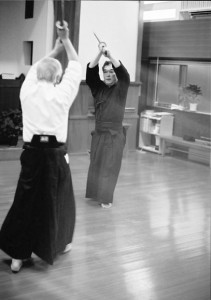
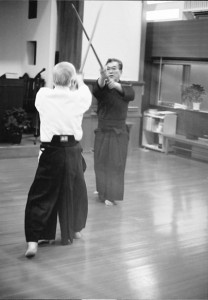
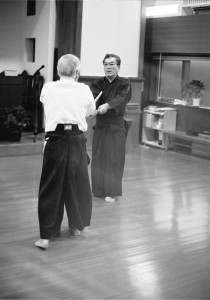
Huh? I thought. This was because, up until this point, I only saw the same pattern of movement. I was certain that, this time, Uchikata consciously cut in at an angle.
Sasamori Soke: “In this move, you step out ever so slightly with the left foot. Keep your right
foot the same. If feels like the center axis of your body makes a slight shift to the left.”
I had him do it once again and was able to understand after consciously watching him do it a second time. Certainly, the central axis of his body shifted toward the left slightly. By making that slight shift, he was still able to do Kiriotoshi.
Sasamori Soke: “Of course, I was able to respond in this way because I was able to immediately pick up from which direction he was coming from, but in any case you don’t have to rack your brains over trying to figure out where he will attack from. The most important thing is to draw him toward you.”
 The opponent’s line of attack will always be toward you. Don’t chase after his sword, but as you draw him closer, the instant you get him to commit to a technique with body and sword is when you start to do Kiriotoshi.
The opponent’s line of attack will always be toward you. Don’t chase after his sword, but as you draw him closer, the instant you get him to commit to a technique with body and sword is when you start to do Kiriotoshi.
Sasamori Soke: “It is okay if your opponent happens to be tall because it allows you to draw him in close, and then you don’t have to intercept his sword very high. Also, because it is only natural when doing Kiriotoshi that you are on the receiving end of the power of your opponent’s sword as it comes down, the harder he hits, the more effective your Kiriotoshi will be.”
A technique that becomes more effective the more powerfully your opponent hits? If I had just heard this, I would have thought this was some kind of magical technique, but by now I was starting to become convinced.
“In short, getting your opponent to strike is very important. Thinking things like, I want to live won’t do. That is most fundamental. If you are not willing to put your life on the line, your enemy will never come in to cut.”
By a strange coincidence, I returned to where I started this article. In the middle of the article,
I merely wrote things like, “Get your opponent to strike using sen sen no sen timing,” but in reality,
this is not as simple as I thought. You need to be really committed. “It is by sacrificing yourself that
you get a chance to live” is a saying recited over and over in the dojo.
Doesn’t this seem to be something from the martial arts world that was lost after society changed
and we no longer engaged in hand-to-hand combat? This may be due to a lack of resolve on the part of modern man who finds it difficult to understand the deep secrets of the traditional martial arts of
Japan. However, honoring the brave souls who have gone before us will never be hard if we just try to understand today the principles of the martial arts that they left behind. Perhaps they are things we should resurrect in this day and age.
──The Hiden Budo and Bujutsu Magazine,
March 2009
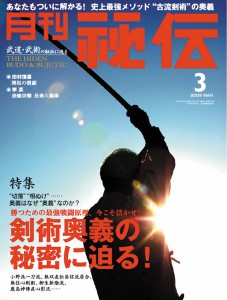
Related article:Ono-ha Itto-ryu’s Takemi Sasamori: A tribute from abroad
Related article:Onoha Itto-ryu:One sword to rule them all
related article:Ono-ha Itto-ryu’s “kiriotoshi”: An “invincible” technique, born in the battlefield














